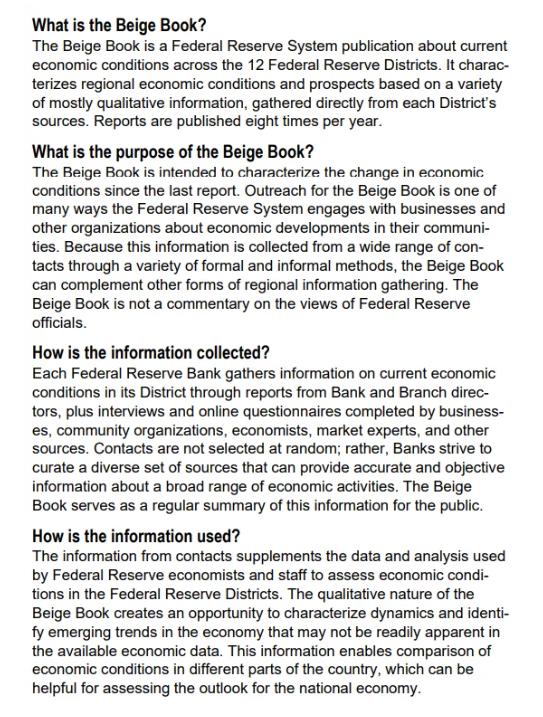https://www.federalreserve.gov/monetarypolicy/files/BeigeBook_20230906.pdf

This report was prepared at the Federal Reserve Bank of Kansas City based on information collected on or before August 28, 2023.
Highlights:
- “Some Districts highlighted reports suggesting consumers may have exhausted their savings and are relying more on borrowing to support spending.”
- “Bankers from different Districts had mixed experiences with growth in loan demand. Most indicated that consumer loan balances rose, and some Districts reported higher delinquencies on consumer credit lines.”
- “Agriculture conditions were somewhat mixed, but reports of drought and higher input costs were widespread.”
- “Many contacts suggested “the second half of the year will be different” when describing wage growth.”
- “Growth in labor cost pressures was elevated in most Districts, often exceeding expectations during the first half of the year.”
- “Contacts in several Districts indicated input price growth slowed less than selling prices, as businesses struggled to pass along cost pressures.”
- “As a result, profit margins reportedly fell in several Districts.
Overall Economic Activity
Contacts from most Districts indicated economic growth was modest during July and August. Consumer spending on tourism was stronger than expected, surging during what most contacts considered the last stage of pent-up demand for leisure travel from the pandemic era. But other retail spending continued to slow, especially on non-essential items. Some Districts highlighted reports suggesting consumers may have exhausted their savings and are relying more on borrowing to support spending. New auto sales did expand in many Districts, but contacts noted this had more to do with better availability of inventory rather than increased consumer demand. Manufacturing contacts in several Districts also noted that supply chain delays improved, and that they were better able to meet existing orders. New orders were stable or declined in most Districts, and backlogs shortened as demand for manufactured goods waned. One sector where supply did not become more available was single-family housing. Nearly all Districts reported the inventory of homes for sale remained constrained. Accordingly, new construction activity picked up for single-family housing. But multiple Districts noted that construction of affordable housing units was increasingly challenged by higher financing costs and rising insurance premiums. Bankers from different Districts had mixed experiences with growth in loan demand. Most indicated that consumer loan balances rose, and some Districts reported higher delinquencies on consumer credit lines. Agriculture conditions were somewhat mixed, but reports of drought and higher input costs were widespread. Energy activity was mostly unchanged during the final months of the summer.
Labor Markets
Job growth was subdued across the nation. Though hiring slowed, most Districts indicated imbalances persisted in the labor market as the availability of skilled workers and the number of applicants remained constrained. Worker retention improved in several Districts, but only in certain sectors such as manufacturing and transportation. Many contacts suggested “the second half of the year will be different” when describing wage growth. Growth in labor cost pressures was elevated in most Districts, often exceeding expectations during the first half of the year. But nearly all Districts indicated businesses renewed their previously unfulfilled expectations that wage growth will slow broadly in the near term.
Prices
Most Districts reported price growth slowed overall, decelerating faster in manufacturing and consumer-goods sectors. However, contacts in several Districts highlighted sharp increases in property insurance costs during the past few months. Contacts in several Districts indicated input price growth slowed less than selling prices, as businesses struggled to pass along cost pressures. As a result, profit margins reportedly fell in several Districts.
- Federal Reserve Bank of Boston
- Federal Reserve Bank of New York
- Federal Reserve Bank of Philadelphia
- Federal Reserve Bank of Cleveland
- Federal Reserve Bank of Richmond
- Federal Reserve Bank of Atlanta
- Federal Reserve Bank of Chicago
- Federal Reserve Bank of St. Louis
- Federal Reserve Bank of Minneapolis
- Federal Reserve Bank of Kansas City
- Federal Reserve Bank of Dallas
- Federal Reserve Bank of San Francisco
TLDRS:
- Fed’s Beige Book August 2023: “Some Districts highlighted reports suggesting consumers may have exhausted their savings and are relying more on borrowing to support spending.” “Many contacts suggested “the second half of the year will be different” when describing wage growth.
- Are they calling for a crash since that would bring wages down and make it ‘different’ as wages have only been going up?
- “Agriculture conditions were somewhat mixed, but reports of drought and higher input costs were widespread.”
- AKA get ready for higher food prices (mor inflation!)
Will someone please think of the profit margins?!?!:
- “Contacts in several Districts indicated input price growth slowed less than selling prices, as businesses struggled to pass along cost pressures.”
- “As a result, profit margins reportedly fell in several Districts.
Views: 77